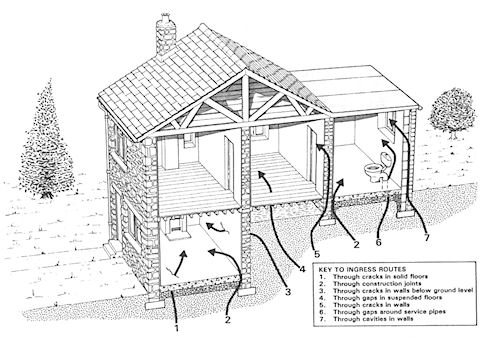Radon Solutions
The diagram below (BRE) illustrates clearly how radon can get into a building.

Radon becomes a problem when its levels increase. Radon Scotland Limited offer a range of radon solutions. We are approved contractors of The Radon Council and follow the recommendations set out by, Public Health England, BRE and the Scottish Government.
Once we have established a property's radon reading, we will consider a number of factors directly related to the property and also to its use by its inhabitants. We will then offer the most suitable radon solution.
An example of the solutions that Radon Scotland offer are:
Active sumps
These are an effective way to reduce radon levels in a solid floored property.
We are happy to fit low level sumps and high level sumps. Unless there is limited space, the fans are housed in a protective box, this reduces noise, makes the system more aesthetically pleasing and provides protection from the elements.
Positive Pressure Fans
These fans are generally located in the loft and blow air into the property, which dilutes any radon present. These work well in properties that are well sealed and were the windows generally remain closed. These systems are also very effective for dealing with condensation problems. The air can be heated and thermostatically controlled.
Active underfloor ventilation systems
This method is used to dilute the air under a suspended floor. Using a fan, air is blown into the cavity. In some cases it might be more suitable to extract the air from the cavity. Both options will aid the reduction of radon.
Passive underfloor ventilation systems
A sump without a fan, can also assist in the reduction of radon. Adding additional air bricks can help with the natural ventilation of an underfloor cavity, by increasing the airflow the radon is diluted before it enters the building.
Floor sealing and barriers
In certain circumstances it may be appropriate to prevent radon entering a building by sealing the floor, or by adding a barrier. Normally, an airtight membrane, similar to a damp proof membrane. These can be particularly useful in basements when radon can access the building through the walls and the floor areas, due to the close proximity of the soil, on all surfaces.
These methods are not always sufficient to reduce radon to its desired level, so where deemed appropriate, work well with other remedial solutions.




